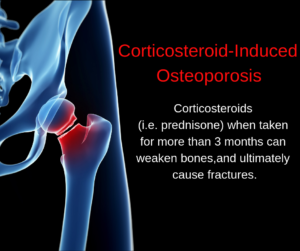This could be a wake-up call to action!
Glucocorticoids or steroid medications taken for many medical conditions to help you feel better, can end up creating a serious bone fracture and disease problem for many adults. The question to ask yourself, and your family doctor or rheumatologist is, “Am I exchanging one problem for another?”
What are glucocorticoids, and why does my doctor prescribe them, if they lead to bone fractures and osteoporosis? Your body has naturally-occurring glucocorticoids, or steroid hormones, that have many important functions. They help to interrupt or suppress inflammation, help your body respond to stress, and regulate how your body uses fat and sugar.
Many health problems involve inflammation, and if your body’s natural glucocorticoids are not performing well, drug assistance may be indicated. Glucocorticoid drugs are man-made, or synthetic versions of natural glucocorticoids, and can help suppress inflammation from autoimmune reactions, reducing pain, swelling, cramping, and itching. They are prescribed to treat autoimmune diseases like arthritis, rheumatoid arthritis or lupus; skin conditions like psoriasis or eczema; allergic reactions; breathing disorders like COPD and asthma; inflammatory bowel disease like Crohn’s or ulcerative colitis; various cancers, multiple sclerosis; surgery recovery, or sepsis. These drugs are effective in stopping damaging inflammation, but are more potent than the naturally occurring steroids and can cause serious damage.
According to the January 2, 2019 New England Journal of Medicine (NEJM), approximately 1% of all adults and 3% of adults older than 50 years of age receive glucocorticoids for allergies, inflammatory conditions, or cancer. Long-term use of glucocorticoids is associated with clinically significant toxic effects. Fracture, followed by diabetes, is the most common serious and preventable adverse event associated with these agents. The risk of fracture increases with age and with the dose and duration of glucocorticoid use. Here are the facts.
Vertebral fractures are the most common fractures associated with glucocorticoids; the risk of vertebral fracture increases within 3 months after initiation of treatment and peaks at 12 months. The relative risk of clinically diagnosed vertebral fracture doubles and the risk of hip fracture increases by approximately 50% among patients who receive 2.5 to 7.5 mg of prednisolone daily. In a study with a follow-up of 6 months to 10 years, glucocorticoids taken at very high doses significantly increased the risk of vertebral fractures.
Glucocorticoids have direct and indirect effects on bone remodeling. Bone loss can lead to an early increased risk of fracture and osteoporosis. Bone formation also decreases early in glucocorticoid treatment. Indirect glucocorticoid effects predispose patients to reduced muscle mass leading to an increased risk of falls, decreases in renal calcium resorption and levels of sex hormones, and alterations in parathyroid hormone functioning.
The risk of fracture rapidly decreases when glucocorticoids are discontinued. A prospective study showed clinically significant improvement in bone mineral density at the lumbar spine within 6 months after discontinuation of glucocorticoids. A large retrospective study showed an increased risk of a major osteoporotic fracture among patients with recent prolonged glucocorticoid use but not among those with intermittent or past use of these drugs.
What you need to know from this NEJM Report
- Risk factors for glucocorticoid-induced fractures include age (>55 years), female sex, white race, and long-term use of prednisone at a dose of more than 7.5 mg per day.
- Screening for fracture risk should be performed soon after the initiation of glucocorticoid treatment. The risk of fracture among patients who are 40 years of age or older can be estimated with the use of bone mineral density testing and the fracture risk assessment tool (FRAX).
- Patients who receive glucocorticoids should be counseled about adequate intake of calcium and vitamin D, weight-bearing exercise, and avoidance of smoking and excessive alcohol intake.
- Pharmacologic treatment is strongly recommended for anyone who has had a fracture and for patients who are at least 40 years of age if, according to the FRAX tool, the risk of major osteoporotic fracture is 20% or higher or the risk of hip fracture is at least 3%. Among patients who are receiving glucocorticoids and have a bone mineral density T score of −2.5 or less (indicating osteoporosis) at either the spine or the femoral neck, pharmacologic treatment is also recommended for men who are 50 years of age or older and for postmenopausal women.
- Bisphosphonates (i.e. Fosamax, Actonel) are recommended as first-line treatment of osteoporosis because of their low cost and safety.
- The risk of fracture decreases rapidly when glucocorticoids are discontinued. Exposure to glucocorticoids should be minimized as much as possible.
Non-drug options that can help (with or without taking glucocorticoids) bone loss, osteoporosis and fractures
- Weight-bearing exercise, maintenance of normal weight, smoking cessation, limitation of alcohol consumption, and the assessment and management of fall risks.
- Calcium and Vitamin D: Adequate dietary intake of 1,000 mg calcium per day and 600-800 IU of vitamin D (600 to 800 IU) is routinely encouraged in patients who receive glucocorticoids.
- Bisphosphonates increase bone mineral density, help strengthen bone preventing further weakness, and slow down further bone loss.
Be an informed consumer! Talk to your doctor about glucocorticoid drugs that include beclomethasone, betamethasone, budesonide, cortisone, dexamethasone, hydrocortisone, methylprednisolone, prednisolone, prednisone and triamcinolone.
Make every effort to reduce your chance of disabling osteoporosis, fractures and bone loss. Discuss all medication and potential side effects with your primary care doctor, rheumatologist, and/or endocrinologist and together, make the best choices for your overall health and well-being.


